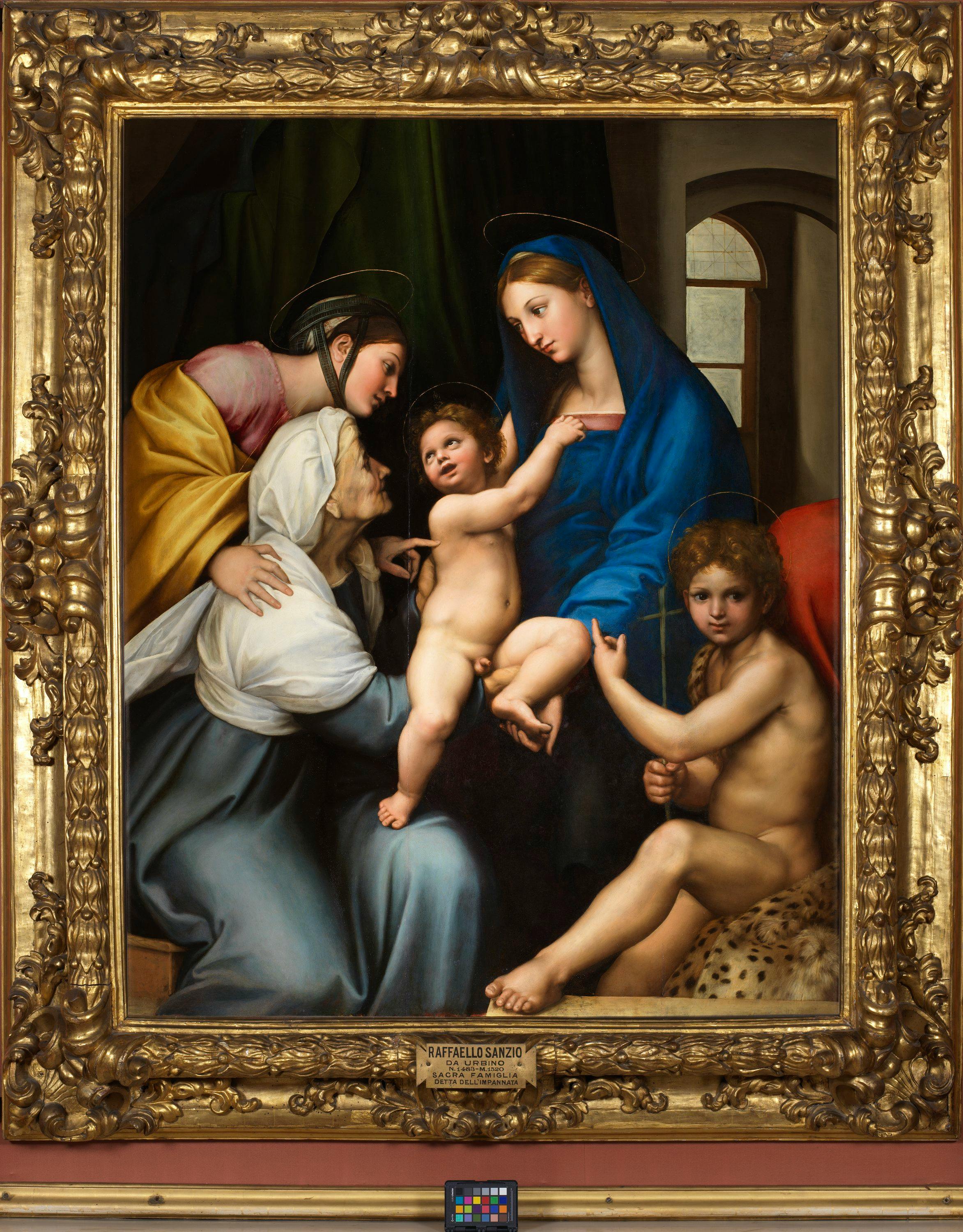Madonna col Bambino e i santi Elisabetta, Maddalena (?) e Giovanni Battista detta “Madonna dell’Impannata”
Raphael (Urbino 1483 – Rome 1520)
The simple and bare interior of a room, bordered on the left by a green curtain and on the right by an archway opening onto the “impannata” window space, or a window closed off with cloth or fabric panels, provides a spatial frame for the scene. The main group is formed by the Virgin on the right and two women on the left: the older one, kneeling and almost on her back, has been identified as both St. Elizabeth, mother of John the Baptist, and St. Anne, mother of the Virgin. The younger one, who lovingly bends over the old woman to rest her hand on her shoulder, does not have any distinguishing features other than the sash that gathers her hair, fastened by a dark ribbon that goes around her head and descends below her chin, and has been identified both as Saint Catherine of Alexandria and as Magdalene, a saint to whom the person commissioning the work was particularly devoted. The centrepiece of the composition is a very young Jesus, toddling, who clings to his mother's robe as Elizabeth hands it to him. The child turns his head towards the young woman behind him, and she touches his side with her finger as if to tickle him. This tender gesture provokes Jesus' squealing, excited laughter, a feeling of gaiety that did not fail to capture the attention of Vasari, who noted in his Vite: “he was of such beauty in the nakedness and features of his face that his laughter cheers up anyone who looks at him”. The biographer from Arezzo was the first to mention the circumstances of the commissioning of the painting, ordered by Bindo Altoviti, a wealthy Florentine merchant and banker who had important business in Rome at the papal court, and immortalised by the artist from Urbino in an unforgettable portrait now in the National Gallery in London. Probably painted on the occasion of Bindo's second marriage to Fiammetta Soderini, the Madonna dell'Impannata was sent to Florence probably around 1515, to the family palace located in Borgo Santi Apostoli where it remained for more than three decades, inspiring the minds of Florentine artists from Andrea del Sarto to Pontormo and others. Later, Bindo's luck was turned against him by his membership in the anti-Medici party against which Cosimo I de' Medici's vengeance fell. His Tuscan possessions were confiscated and the Madonna dell'Impannata was included in the Medici collections in 1554. It was Vasari himself, instructed by the duke, who arranged it in the Palazzo Vecchio, putting it in the centre of the altar in the “new rooms”, known as the flat of Leo X, in a prominent position that paid homage to Raphael's greatness in the Rome of the Medici pope and also - exemplarily - sanctioned Cosimo's political affirmation.
The painting was completed at the beginning of the second decade of the 16th century, when Raphael was establishing his reputation in Rome after having finished the first of the Vatican Rooms, the Room of the Segnatura, and was preparing to begin the Room of Heliodorus. The long-range comparison with Michelangelo and the increasingly profound likeness of ancient sculpture are the basis of this painting, in which the skilfully calibrated colours, the flowing and at the same time full-bodied drapery, the infinite sweetness of the expressions, each one carefully studied in its emotional expression, make up the traits of that ‘grace’ that historians and scholars recognised as Raphael's distinctive quality from the very beginning.
However, the artist reached this original invention after having planned, and partly completed, another composition, with a bearded man in profile to the right of the Virgin, as revealed by x-ray investigations carried out in 1938. It was undoubtedly supposed to be Saint Joseph, the natural complement to the evangelical account of Jesus' childhood and its pictorial translation, but it was later replaced by a Saint John, placed a little lower on the precious leopard skin and given the task of indicating to the spectator the affectionate encounter taking place in the centre of the scene. Further diagnostic examinations, carried out during the last restoration in 2017 at the Opificio delle Pietre Dure in Florence, certified that the young saint also held a different position, further back and more profiled. For these reasons, too, some scholars believe that only the two saints were completed personally by the master, while the two children and the Virgin would have been completed by the pupils. Two drawings, one at Windsor Castle (Inv. RL12742) and the other at Berlin (Kupferstichkabinett, Inv. 2231), further explore the position and pose of the central figures.
Raffaello a Firenze. Dipinti e disegni delle collezioni fiorentine, catalogo della mostra (Firenze, Palazzo Pitti, 11 gennaio - 29 aprile 1984), a cura di L.Berti e M.Chiarini, Firenze - Milano 1984, pp. 67-68; Ritratto di un banchiere del Rinascimento: Bindo Altoviti tra Raffaello e Cellini, catalogo della mostra, (Firenze, Museo del Bargello 02 marzo al 15 giugno 2004), A cura di A. Chong, D.Pegazzano e D.Zikos, Boston-Milano 2004; S. Padovani, in I dipinti della Galleria Palatina e degli Appartamenti Reali.Le Scuole dell’Italia Centrale 1450-1530, a cura di S.Padovani in scheda 67, pp.303-314.
